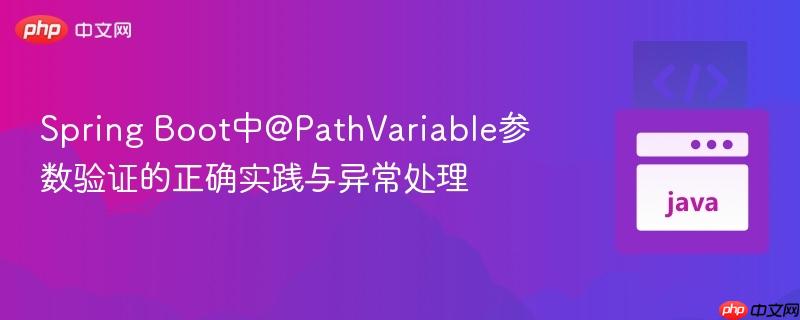
本文详细探讨了spring boot中如何对@pathvariable参数进行有效验证。通过讲解@validated注解的正确使用、内置验证注解(如@min)的应用,并重点阐述了如何通过全局异常处理器捕获constraintviolationexception,从而将默认的500错误转换为更友好的400 bad request响应,提升api的健壮性和用户体验。
在Spring Boot应用中,@PathVariable注解常用于从URL路径中提取参数。然而,仅仅在这些路径变量上添加JSR 303/380(Bean Validation)注解(如@Min, @Max, @Pattern等)并不能立即生效,尤其是在没有正确配置Spring的验证机制时。本文将深入探讨@PathVariable参数验证的正确实践,并提供优雅的异常处理方案。
开发者在使用@PathVariable时,可能会尝试直接在其上添加@Valid注解或验证注解,但发现验证并未如预期触发,或者在验证失败时收到一个通用的500 Internal Server Error。这主要是因为:
要使@PathVariable上的验证注解生效,关键在于在Controller类或方法上添加@Validated注解。@Validated注解是Spring提供的,它激活了Spring对方法参数的验证功能,使其能够识别并处理参数上的JSR 303/380验证注解。
以下是一个正确应用@Validated注解和@Min注解的示例:
import org.springframework.http.ResponseEntity;
import org.springframework.validation.annotation.Validated;
import org.springframework.web.bind.annotation.GetMapping;
import org.springframework.web.bind.annotation.PathVariable;
import org.springframework.web.bind.annotation.RequestMapping;
import org.springframework.web.bind.annotation.RestController;
import javax.validation.constraints.Min;
import java.util.List;
import java.util.ArrayList; // 示例用
@RestController
@Validated // 关键:激活方法参数验证
@RequestMapping("/api/v1")
public class EmployeeController {
// 假设 ApiResponse 和 Employee 存在,这里仅为示例提供简化定义
public static class ApiResponse<T> {
private String message;
private T data;
public ApiResponse(String message, T data) {
this.message = message;
this.data = data;
}
// Getters and setters (省略)
}
public static class Employee {
private Long id;
private String name;
public Employee() {
this.id = 1L; // 示例数据
this.name = "Test Employee";
}
// Getters and setters (省略)
}
@GetMapping("/employees/{limit}")
public ResponseEntity<ApiResponse<List<Employee>>> findTopNEmployeeBySalary(
@PathVariable("limit") @Min(value = 1, message = "查询限制参数limit必须大于等于1") int limit) {
// 业务逻辑:根据limit查询员工
List<Employee> employees = new ArrayList<>();
for (int i = 0; i < limit; i++) {
employees.add(new Employee());
}
return ResponseEntity.ok(new ApiResponse<>("查询成功", employees));
}
}在上述代码中:
当@Validated生效且@PathVariable参数验证失败时,例如向 /api/v1/employees/0 发送请求,服务器会抛出javax.validation.ConstraintViolationException。如果没有自定义的异常处理器,Spring Boot的默认行为通常是返回一个500 Internal Server Error,并在响应体中包含一个通用的错误信息,例如:

动态WEB网站中的PHP和MySQL详细反映实际程序的需求,仔细地探讨外部数据的验证(例如信用卡卡号的格式)、用户登录以及如何使用模板建立网页的标准外观。动态WEB网站中的PHP和MySQL的内容不仅仅是这些。书中还提到如何串联JavaScript与PHP让用户操作时更快、更方便。还有正确处理用户输入错误的方法,让网站看起来更专业。另外还引入大量来自PEAR外挂函数库的强大功能,对常用的、强大的包
 525
525

// 请求:GET http://localhost:8080/api/v1/employees/0
{
"timestamp": "2023-10-27T10:30:00.000+00:00",
"status": 500,
"error": "Internal Server Error",
"path": "/api/v1/employees/0"
}同时,服务器日志中会打印详细的ConstraintViolationException堆栈信息,其中包含具体的验证失败原因。这种默认行为对于API消费者来说并不友好,因为它隐藏了真正的错误类型和详细的验证消息。
为了提供更清晰、更友好的API错误响应,我们应该实现一个全局异常处理器来捕获ConstraintViolationException,并将其转换为400 Bad Request响应,同时包含具体的验证错误信息。这可以通过@ControllerAdvice和@ExceptionHandler注解实现:
import org.springframework.http.HttpStatus;
import org.springframework.http.ResponseEntity;
import org.springframework.web.bind.annotation.ControllerAdvice;
import org.springframework.web.bind.annotation.ExceptionHandler;
import javax.validation.ConstraintViolation;
import javax.validation.ConstraintViolationException;
import java.util.HashMap;
import java.util.Map;
import java.util.stream.Collectors;
@ControllerAdvice
public class GlobalExceptionHandler {
/**
* 处理 @PathVariable 或 @RequestParam 参数验证失败的异常
* 返回 400 Bad Request
*/
@ExceptionHandler(ConstraintViolationException.class)
public ResponseEntity<Map<String, String>> handleConstraintViolationException(ConstraintViolationException ex) {
Map<String, String> errors = new HashMap<>();
String errorMessage = ex.getConstraintViolations().stream()
.map(violation -> {
// 提取参数名。例如,对于 "findTopNEmployeeBySalary.limit: must be greater than or equal to 1"
// 我们希望只显示 "limit: must be greater than or equal to 1"
String propertyPath = violation.getPropertyPath().toString();
int lastDotIndex = propertyPath.lastIndexOf('.');
String paramName = (lastDotIndex != -1 && lastDotIndex < propertyPath.length() - 1) ?
propertyPath.substring(lastDotIndex + 1) : propertyPath;
return paramName + ": " + violation.getMessage();
})
.collect(Collectors.joining("; ")); // 多个验证错误用分号连接
errors.put("error", "Validation Failed");
errors.put("details", errorMessage);
return new ResponseEntity<>(errors, HttpStatus.BAD_REQUEST);
}
// 可以根据需要添加其他异常处理方法
}通过这个全局异常处理器,当@PathVariable验证失败时,API将返回一个400 Bad Request状态码,响应体中包含清晰的错误描述:
// 请求:GET http://localhost:8080/api/v1/employees/0
{
"error": "Validation Failed",
"details": "limit: 查询限制参数limit必须大于等于1"
}这种响应方式显著提升了API的可用性和开发体验,让调用方能够清晰地理解请求失败的原因。
对@PathVariable参数进行有效验证是构建健壮RESTful API的关键一环。通过在Controller类上正确使用@Validated注解,并结合JSR 303/380验证注解,我们可以确保路径参数的合法性。更重要的是,通过实现一个@ControllerAdvice来捕获并处理ConstraintViolationException,我们可以将默认的500 Internal Server Error转换为更具描述性的400 Bad Request,从而极大地提升API的用户体验和可维护性。遵循这些实践,将有助于构建更稳定、更易于集成的Spring Boot应用。
以上就是Spring Boot中@PathVariable参数验证的正确实践与异常处理的详细内容,更多请关注php中文网其它相关文章!

每个人都需要一台速度更快、更稳定的 PC。随着时间的推移,垃圾文件、旧注册表数据和不必要的后台进程会占用资源并降低性能。幸运的是,许多工具可以让 Windows 保持平稳运行。

Copyright 2014-2025 https://www.php.cn/ All Rights Reserved | php.cn | 湘ICP备2023035733号